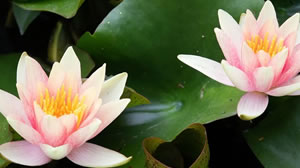| Sacred Lotus Nelumbo nucifera 6 Seeds Indian lotus, sacred lotus bean of India, Egyptian bean Water Lily Pink Flowers Quite easy to germinate We trim of the ends of the hard shell without catching the inside, we then place them in a bowl of water in a warm place with light and change the water every day Once the shell is soft we remove this (takes a few days) and after a while a shoot will appear, we still change the water every day but be very careful not to break the shoot Once the shoot is a few inches long we transfer to a muddy nutrient-rich loamy soil planting the seed and ensure about 8 inches of water on top of the mud The first few photos show adult plants and flowers the next couple show early stages of growth and the last photo shows how the seeds look Nelumbo nucifera, also known as Indian lotus, sacred lotus,bean of India, Egyptian bean or simply lotus, is one of two extant species of aquatic plant in the family Nelumbonaceae. It is often colloquially called a water lily. Lotus plants are adapted to grow in the flood plains of slow-moving rivers and delta areas. Stands of lotus drop hundreds of thousands of seeds every year to the bottom of the pond. While some sprout immediately, and most are eaten by wildlife, the remaining seeds can remain dormant for an extensive period of time as the pond silts in and dries out. During flood conditions, sediments containing these seeds are broken open, and the dormant seeds rehydrate and begin a new lotus colony. Under favorable circumstances, the seeds of this aquatic perennial may remain viable for many years, with the oldest recorded lotus germination being from seeds 1,300 years old recovered from a dry lakebed in northeastern China. Therefore, the Chinese regard the plant as a symbol of longevity. It has a very wide native distribution, ranging from central and northern India (at altitudes up to 1,400 m or 4,600 ft in the southern Himalayas), through northern Indochina and East Asia (north to the Amur region; the Russian populations have sometimes been referred to as "Nelumbo komarovii"), with isolated locations at the Caspian Sea. Today the species also occurs in southern India, Sri Lanka, virtually all of Southeast Asia, New Guinea and northern and eastern Australia, but this is probably the result of human translocations. It has a very long history (c. 3,000 years) of being cultivated for its edible seeds, and it is commonly cultivated in water gardens. It is the national flower of India and Vietnam. - In Stock
| 


